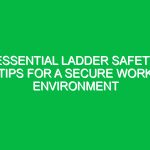Welcome team! Today, we are going to discuss a crucial topic that impacts our daily operations: Falls in the Construction Industry. It is essential to understand the risks associated with falls and how we can prevent them to ensure a safe working environment for everyone.
The Importance of Falls in the Construction Industry
Falls in the Construction Industry are one of the leading causes of workplace injuries and fatalities. As part of our Health, Safety, and Environment (HSE) practices, it is crucial to address this issue proactively to prevent accidents and ensure the well-being of all employees.
Understanding Falls in the Construction Industry
When we talk about falls in the construction industry, we are referring to incidents where workers lose balance and descend from an elevated position. This can occur from scaffolds, ladders, roofs, or any other elevated work areas. The consequences of falls can be severe, leading to injuries, disabilities, or even death.
Potential Hazards and Risks
Some common hazards that contribute to falls in construction include unstable work surfaces, lack of fall protection equipment, improper use of ladders or scaffolds, and human error. It is essential for all employees to be aware of these risks and take necessary precautions to mitigate them.
Best Practices for Fall Prevention
Now, let’s discuss some best practices that can help us prevent falls in the construction industry:
- Proper Training: Ensure that all employees receive adequate training on fall prevention measures, the correct use of equipment, and emergency procedures.
- Use of Fall Protection Equipment: Always wear appropriate fall protection gear such as harnesses, lanyards, and guardrails when working at heights.
- Regular Inspections: Inspect scaffolds, ladders, and other work platforms regularly to identify any defects or hazards that could lead to falls.
- Safe Work Practices: Follow safe work practices, such as maintaining three points of contact on ladders, securing tools and materials, and keeping work areas clear of clutter.
Compliance with Regulations
It is essential to comply with relevant regulations and standards set forth by OSHA (Occupational Safety and Health Administration) and other governing bodies. By adhering to these regulations, we not only ensure the safety of our employees but also fulfill our legal obligations as a company.
Conclusion
In conclusion, preventing falls in the construction industry is a shared responsibility that requires the commitment and cooperation of all employees. By following best practices, staying vigilant, and prioritizing safety, we can create a safer work environment for everyone.
Thank you for your attention during this Toolbox Talk. Let’s continue to prioritize safety in all our operations. Stay safe!


